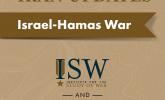Russian Offensive Campaign Assessment, November 22, 2023
November 22, 2023 - ISW Press
Russian President Vladimir Putin reframed the Kremlin’s stance on the Israeli-Hamas war to a much more anti-Israel position in an attempt to demonstrate the supposed hypocrisy of Western condemnations of the Russian invasion of Ukraine. Putin stated that attendees of the G20 summit who expressed shock at the continued Russian war in Ukraine should instead be “shocked” by the “bloody” 2014 Euromaidan Revolution in Ukraine and the subsequent war that the “Kyiv regime waged against its own people” in Donbas and by the “extermination of the civilian population in Palestine, in the Gaza sector.” Putin’s November 22 statement on the Israel-Hamas war referring to the “extermination of the civilian population of Palestine” was a departure from previous Kremlin framing that largely focused on calling for peace and claiming that the Israel-Hamas war will distract from the provision of Western military aid to Ukraine. Putin’s November 22 framing of the Israeli-Hamas war continues to exploit that war to undermine Western support for Ukraine, as ISW has previously assessed, and also signals potentially increasing support for Iranian interests in the region and an increased willingness to antagonize Israel.










